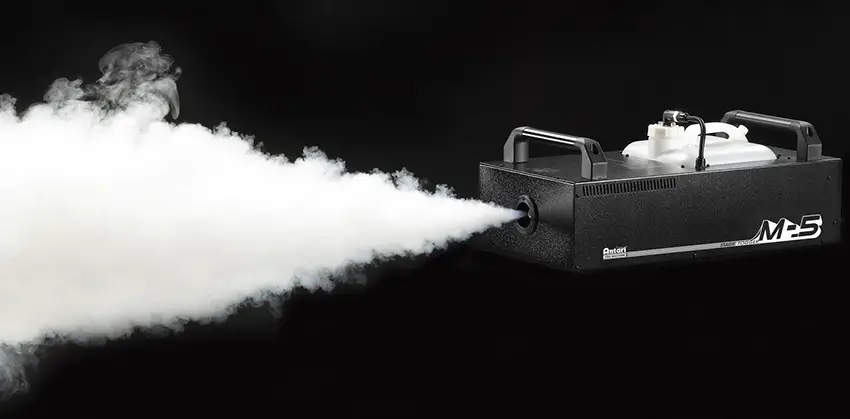Fog machine
A fog machine produces artificial fog by evaporating fog fluid. Therefore, the full name is vaporizing fog generator. Depending on the machine type and the fluid properties of the nebula with respect to durability and density can be changed.
Use
One uses fog machines in film, television and on the stage to create a mysterious atmosphere. They are often used at parties and nightclubs in order to increase the spatial effect of laser lights and spotlights. By scattering the mist droplets light rays are visible almost from the side. Fog gives the room by gradually obscuring depth.
In addition, fog serves as a resource for technical purposes such as speed measurement (by LDA), and the visualization of air and gas flows. When firefighters mist is used as a largely harmless substitute for the vision impaired by smoke and exercises. In the model the rising of smoke from chimneys and steam engines is simulated.
In the application of fog machines in buildings with optical fire alarm systems it comes to trigger the fire alarm.
Operation
From a tank or via a tube system mist fluid is fed, which is pumped by a pump in a heating element. It is then evaporated, being torn apart by the resulting pressure into very fine droplets and ejected through a nozzle at the end of the heating element.
Application
Since fog machines are often installed in hard to reach places (eg on ceilings or behind protective screens ), they are usually controlled via remote control or DMX. In addition to the most fog machines, a switch is still attached to the trigger. A remote control is also available for nearly all fog machines, while the DMX control is usually only supported on top of the device class.
The lifetime of the nebula is highly dependent on the relative humidity. The higher this is, the more durable the fog.
History and other modes of
For centuries, fog and smoke for different purposes with steam or produced pyrotechnic. The development was thereby driven by the need for less harmful and better controlling methods.
Paraffin and heated oils were used after the Second World War to the mid 1980s in film and theater and also in nightclubs. This is no longer allowed because of the flammability of the nebula, the deposits on surfaces and the harmfulness of the oils in the lungs.
Since the 1930s, also dry ice (CO2 -78.5 ° C) and hot water is used. The dry ice machines also flourished in the disco boom of the 1970s (eg Altman, NY, LEMAITRE, UK) and have become increasingly rare in the 1990s, as transport vehicles of dry ice cooling were converted to compressor cooling and the cost of dry ice was almost impossible to get.
Of 1973, who lives in Schenefeld near Hamburg Günther Schaidt today's fog fluid and machines for that. In such a mixture of double-distilled water (to prevent mineral deposits ) and high-purity glycols pressed about with a piston pump through a check valve in a tubular heated to about 300 ° C heating element with a narrow scale and evaporated. The glycol vapor then condenses as it leaves the nozzle of the device at the same time from jet breakup to " visible smoke " in the form of microscopic droplets ( aerosol). Schaidt got a technical Oscar for this development in Hollywood.
Virtually all subsequent time fog machines copy the operating principle of this Safex machines.
Some machines to produce weaker Dunst ( Hazer ) using ultrasonic and spray water purely mechanical, like a mist fountain for home use, however, these devices are often high-maintenance ( clogged nozzles ) and are now hardly produced.
The generation of ground fog was originally achieved mostly by dry ice (solid CO2 from -78 ° C from the insulated box ) under condensation of existing humidity. By changing availability rather cryogenic liquid nitrogen from a Dewar, a cold-insulating by silvering of glass, or polished metal and vacuum or foam bottle is now used instead. Unlimited shelf life, however, is under high pressure liquefied CO2 in a steel cylinder ( with rupture disc over-pressure ). A riser pipe to the base of the standing bottle permits the rapid removal of the liquid phase, which rapidly evaporates at ambient pressure, it cools, is partly to solid carbon dioxide snow, which further absorbs heat on sublimation. While all the CO2 it becomes gaseous, is by cooling from the humid ambient air water mist (and possibly some snow ) formed.
Due to the poor availability and shelf life is now, however, often with cryogenic liquid nitrogen, liquid CO2 ( from pressurized containers, so can be stored indefinitely, unlike dry ice) worked or cooling of the nebula from evaporator machines. However, dry ice fog is still regarded as the "most beautiful ground fog " because it is snow-white and its high density "flows" (because of the reduced temperature and enrichment with CO2) over the ground.
In another type of machines are two chemicals out of pressure vessels, usually similar to a spray can, mixed and burned to a nozzle. Advantage is that the machines are compact, and that no power supply is needed, adversely, the high operating costs, the risk of fire and the fact that the mist is harmful. They were to about the mid-1980s, particularly in the area of film production, are used.









